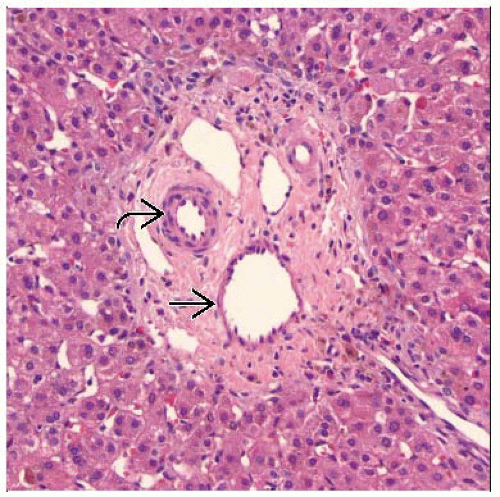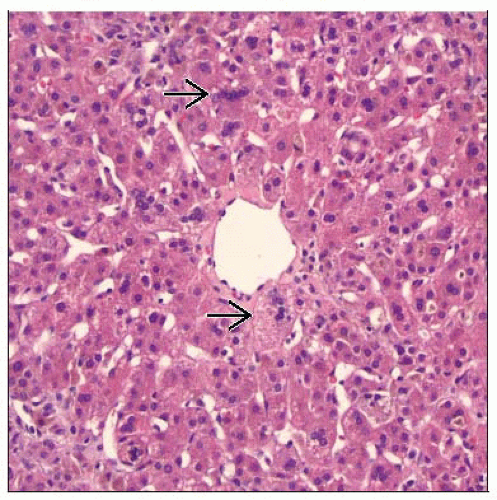Paucity of Intrahepatic Bile Ducts (Nonsyndromic)
Joseph Misdraji, MD
Key Facts
Terminology
Heterogeneous group of disorders that causes bile duct paucity in patients without congenital abnormalities indicative of Alagille syndrome
Ductopenia is diagnosed when > 50% of portal tracts lack bile ducts
Etiology/Pathogenesis
Congenital disorders: Extrahepatic biliary atresia
Metabolic disorders: α-1-antitrypsin deficiency, cystic fibrosis, PFIC, peroxisomal disorders, disorders of bile acid synthesis, Niemann-Pick type C, ARC
Chromosomal abnormalities: Turner syndrome, monosomy X, trisomies
Intrauterine infections: CMV, rubella, syphilis
Idiopathic: Diagnosis of exclusion Clinical Issues
Prognosis varies depending on underlying cause and ranges from liver failure to complete resolution
Treated with ursodeoxycholic acid and drugs to combat pruritus
About 45% progress to cirrhosis, requiring liver transplantation
Microscopic Pathology
Native bile ducts absent in > 1/2 of portal tracts
Intracellular cholestasis and giant cell transformation of hepatocytes
Fibrosis ranging from portal fibrosis to cirrhosis
TERMINOLOGY
Synonyms
Hypoplasia of intrahepatic bile ducts
Intrahepatic biliary atresia
Definitions
Heterogeneous group of disorders that causes bile duct paucity or ductopenia in patients without congenital abnormalities indicative of Alagille syndrome
Ductopenia is defined as significant decrease in number of interlobular bile ducts
Ratio of number of interlobular bile ducts to number of portal tracts is < 0.4, with normal between 0.9 and 1.8
Alternatively, ductopenia is diagnosed when > 50% of portal tracts lack bile ducts; normally, 80-100% of portal tracts contain ducts
ETIOLOGY/PATHOGENESIS
Developmental Anomaly
Congenital disorders: Extrahepatic biliary atresia
Metabolic disorders: α-1-antitrypsin deficiency, cystic fibrosis, progressive familial intrahepatic cholestasis (PFIC), peroxisomal disorders, disorders of bile acid synthesis, Niemann-Pick type C, arthrogryposis-renal dysfunction-cholestasis syndrome (ARC)
Chromosomal abnormalities: Turner syndrome, monosomy X, trisomies
Infectious Agents
Intrauterine infections: Cytomegalovirus (CMV), rubella, syphilis
Idiopathic
Accounts for variable percentage of total cases, depending on population studied
Idiopathic group has been diminishing as metabolic and genetic mechanisms of ductopenia are elucidated
Diagnosis of exclusion
CLINICAL ISSUES
Epidemiology
Incidence
Varies according to population evaluated but increased in regions of world where consanguineous marriage is common
Age
Generally considered disease of childhood since adults with ductopenia are classified in different disease categories
Some patients with idiopathic adulthood ductopenia may represent late presentation of disorder that began in childhood
Presentation
Jaundice and acholic stools
Pruritus
Hepatomegaly
Laboratory Tests
Increased alkaline phosphatase, γ-glutamyl transpeptidase, and serum bilirubin
Increased serum cholesterol may be seen
Natural History
Complications of fat malabsorption and deficiency of fat-soluble vitamins: Prolonged prothrombin time, rickets, vitamin E-responsive hemolytic anemia, corneal ulcers
Stay updated, free articles. Join our Telegram channel

Full access? Get Clinical Tree







